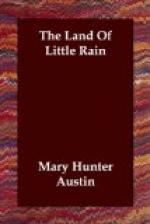And never a coyote comes out of his lair for killing, in the country of the carrion crows, but looks up first to see where they may be gathering. It is a sufficient occupation for a windy morning, on the lineless, level mesa, to watch the pair of them eying each other furtively, with a tolerable assumption of unconcern, but no doubt with a certain amount of good understanding about it. Once at Red Rock, in a year of green pasture, which is a bad time for the scavengers, we saw two buzzards, five ravens, and a coyote feeding on the same carrion, and only the coyote seemed ashamed of the company.
Probably we never fully credit the interdependence of wild creatures, and their cognizance of the affairs of their own kind. When the five coyotes that range the Tejon from Pasteria to Tunawai planned a relay race to bring down an antelope strayed from the band, beside myself to watch, an eagle swung down from Mt. Pinos, buzzards materialized out of invisible ether, and hawks came trooping like small boys to a street fight. Rabbits sat up in the chaparral and cocked their ears, feeling themselves quite safe for the once as the hunt swung near them. Nothing happens in the deep wood that the blue jays are not all agog to tell. The hawk follows the badger, the coyote the carrion crow, and from their aerial stations the buzzards watch each other. What would be worth knowing is how much of their neighbor’s affairs the new generations learn for themselves, and how much they are taught of their elders.
So wide is the range of the scavengers that it is never safe to say, eyewitness to the contrary, that there are few or many in such a place. Where the carrion is, there will the buzzards be gathered together, and in three days’ journey you will not sight another one. The way up from Mojave to Red Butte is all desertness, affording no pasture and scarcely a rill of water. In a year of little rain in the south, flocks and herds were driven to the number of thousands along this road to the perennial pastures of the high ranges. It is a long, slow trail, ankle deep in bitter dust that gets up in the slow wind and moves along the backs of the crawling cattle. In the worst of times one in three will pine and fall out by the way. In the defiles of Red Rock, the sheep piled up a stinking lane; it was the sun smiting by day. To these shambles came buzzards, vultures, and coyotes from all the country round, so that on the Tejon, the Ceriso, and the Little Antelope there were not scavengers enough to keep the country clean. All that summer the dead mummified in the open or dropped slowly back to earth in the quagmires of the bitter springs. Meanwhile from Red Rock to Coyote Holes, and from Coyote Holes to Haiwai the scavengers gorged and gorged.
The coyote is not a scavenger by choice, preferring his own kill, but being on the whole a lazy dog, is apt to fall into carrion eating because it is easier. The red fox and bobcat, a little pressed by hunger, will eat of any other animal’s kill, but will not ordinarily touch what dies of itself, and are exceedingly shy of food that has been manhandled.




